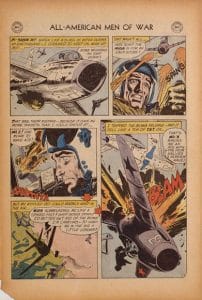An artist, Heath liked drawing from when he was a young boy, and by the time he was in high school, he had freelance gigs to draw for comic books (Captain Aero Comics, 1942-1944). A stint in the Army gave him an even greater appreciation for detail, and once he was out and drawing full time, he bought Army equipment from surplus stores to use for reference, which “set him apart,” said fellow comic book artist Joe Kubert. “He could illustrate mechanical things like rifles and tanks in a realistic way that few other artists could. He would build models of the things he would draw prior to drawing them and his stuff would come out right on the button. Other artists used to keep what they called a swipe file — pictures of things they may have to draw someday that they could use for reference. Russ’s work was so good, other artists used it as reference.”
Heath’s work was mainly for “adult” comics, not kid stuff — such as his war material, 1976’s “Tough Cop”, National Lampoon illustrations, or “Little Annie Fanny” for Playboy. He rarely wrote the material, but brought other writers’ work to life. In addition to western and war themes, Heath illustrated science fiction, romance, gladiators, Robin Hood, Terry and the Pirates, and Flash Gordon. He even worked on a 1980s revival of The Lone Ranger. Heath was “a master of texture and lighting and meticulous levels of detail,” said former DC Comics president Paul Levitz. “Given the chance he’d draw every barnacle on a sunken pirate ship.” The result was so realistic that pop artist Roy Lichtenstein used many of Heath’s drawings for his own comic-book-inspired oil paintings — without paying royalties, or even giving credit. Heath wrote a comic about the ripoff as a tribute to the Hero Initiative, which helps struggling comic creators. At one point, they helped him get groceries. Heath worked until at least 2011, and died in a retirement community in Long Beach, Calif., on August 23, from cancer. He was 91.
– – –
A page of Heath’s artwork in “All-American Men of War” and Lichtenstein’s painting “Blam” — both from 1962 (click to see larger):


